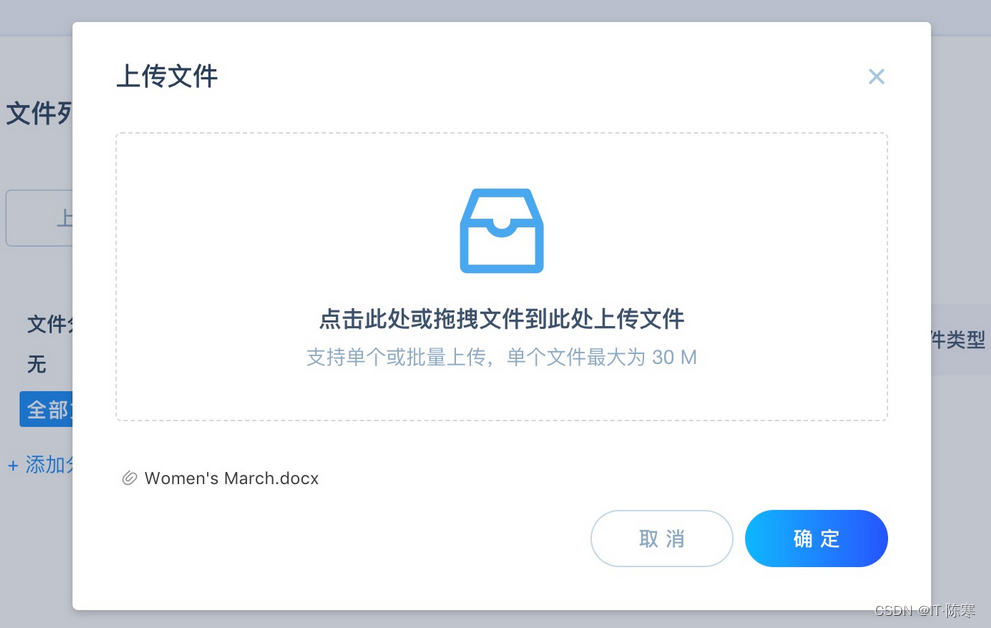文章目录
- 引言
- 1. 环境配置
- 2. 文件上传
- 2.1 配置文件上传路径
- 2.2 创建上传服务
- 2.3 创建上传控制器
- 3. 文件下载
- 3.1 创建下载服务
- 3.2 创建下载控制器
- 4. 前端页面
- 4.1 文件上传页面
- 4.2 文件下载页面
- 5. 技术分析
- 结论

🎉欢迎来到SpringBoot框架学习专栏~
- ☆* o(≧▽≦)o *☆嗨~我是IT·陈寒🍹
- ✨博客主页:IT·陈寒的博客
- 🎈该系列文章专栏:SpringBoot
- 📜其他专栏:Java学习路线 Java面试技巧 Java实战项目 AIGC人工智能 数据结构学习
- 🍹文章作者技术和水平有限,如果文中出现错误,希望大家能指正🙏
- 📜 欢迎大家关注! ❤️
引言
在现代Web应用程序中,文件上传和下载是非常常见的功能。无论是用户上传头像、上传文档还是下载报告,都需要一个高效、安全的文件处理系统。Spring Boot 作为一个流行的Java框架,为开发者提供了简便的方式来实现这些功能。在这篇文章中,我们将探讨如何在Spring Boot应用中实现文件的上传和下载,并包含详细的代码解析和技术分析。

1. 环境配置
在开始编码之前,我们需要配置Spring Boot项目。假设你已经创建了一个Spring Boot项目,以下是需要添加的依赖项:
<dependencies><dependency><groupId>org.springframework.boot</groupId><artifactId>spring-boot-starter-web</artifactId></dependency><dependency><groupId>org.springframework.boot</groupId><artifactId>spring-boot-starter-thymeleaf</artifactId></dependency><dependency><groupId>org.springframework.boot</groupId><artifactId>spring-boot-starter-data-jpa</artifactId></dependency><dependency><groupId>org.springframework.boot</groupId><artifactId>spring-boot-starter-validation</artifactId></dependency>
</dependencies>
2. 文件上传
2.1 配置文件上传路径
首先,我们需要配置文件上传的存储路径。在application.properties中添加以下配置:
file.upload-dir=uploads
2.2 创建上传服务
创建一个服务类来处理文件的存储逻辑。我们将使用Spring的MultipartFile接口来处理上传的文件。
import org.springframework.beans.factory.annotation.Value;
import org.springframework.stereotype.Service;
import org.springframework.web.multipart.MultipartFile;import java.io.IOException;
import java.nio.file.Files;
import java.nio.file.Path;
import java.nio.file.Paths;
import java.util.UUID;@Service
public class FileStorageService {@Value("${file.upload-dir}")private String uploadDir;public String storeFile(MultipartFile file) throws IOException {// 生成唯一文件名String fileName = UUID.randomUUID().toString() + "_" + file.getOriginalFilename();Path targetLocation = Paths.get(uploadDir).resolve(fileName);// 创建目录Files.createDirectories(targetLocation.getParent());// 保存文件Files.copy(file.getInputStream(), targetLocation);return fileName;}
}
2.3 创建上传控制器
接下来,创建一个控制器来处理文件上传请求。
import org.springframework.beans.factory.annotation.Autowired;
import org.springframework.http.HttpStatus;
import org.springframework.http.ResponseEntity;
import org.springframework.web.bind.annotation.*;
import org.springframework.web.multipart.MultipartFile;@RestController
@RequestMapping("/api/files")
public class FileUploadController {@Autowiredprivate FileStorageService fileStorageService;@PostMapping("/upload")public ResponseEntity<String> uploadFile(@RequestParam("file") MultipartFile file) {try {String fileName = fileStorageService.storeFile(file);return ResponseEntity.ok("文件上传成功: " + fileName);} catch (IOException e) {return ResponseEntity.status(HttpStatus.INTERNAL_SERVER_ERROR).body("文件上传失败: " + e.getMessage());}}
}
3. 文件下载
3.1 创建下载服务
同样地,我们需要创建一个服务类来处理文件的下载逻辑。
import org.springframework.beans.factory.annotation.Value;
import org.springframework.core.io.Resource;
import org.springframework.core.io.UrlResource;
import org.springframework.stereotype.Service;import java.io.IOException;
import java.nio.file.Path;
import java.nio.file.Paths;@Service
public class FileDownloadService {@Value("${file.upload-dir}")private String uploadDir;public Resource loadFileAsResource(String fileName) throws IOException {Path filePath = Paths.get(uploadDir).resolve(fileName).normalize();Resource resource = new UrlResource(filePath.toUri());if (resource.exists() || resource.isReadable()) {return resource;} else {throw new IOException("文件未找到或不可读: " + fileName);}}
}
3.2 创建下载控制器
然后,创建一个控制器来处理文件下载请求。
import org.springframework.beans.factory.annotation.Autowired;
import org.springframework.core.io.Resource;
import org.springframework.http.HttpHeaders;
import org.springframework.http.ResponseEntity;
import org.springframework.web.bind.annotation.GetMapping;
import org.springframework.web.bind.annotation.PathVariable;
import org.springframework.web.bind.annotation.RequestMapping;
import org.springframework.web.bind.annotation.RestController;@RestController
@RequestMapping("/api/files")
public class FileDownloadController {@Autowiredprivate FileDownloadService fileDownloadService;@GetMapping("/download/{fileName:.+}")public ResponseEntity<Resource> downloadFile(@PathVariable String fileName) {try {Resource resource = fileDownloadService.loadFileAsResource(fileName);return ResponseEntity.ok().header(HttpHeaders.CONTENT_DISPOSITION, "attachment; filename=\"" + resource.getFilename() + "\"").body(resource);} catch (IOException e) {return ResponseEntity.status(HttpStatus.INTERNAL_SERVER_ERROR).body(null);}}
}
4. 前端页面
为了更好地展示文件上传和下载功能,我们可以使用Thymeleaf来创建一个简单的前端页面。
4.1 文件上传页面
<!DOCTYPE html>
<html xmlns:th="http://www.thymeleaf.org">
<head><title>文件上传</title>
</head>
<body><h1>文件上传</h1><form method="POST" enctype="multipart/form-data" action="/api/files/upload"><input type="file" name="file" /><button type="submit">上传</button></form>
</body>
</html>
4.2 文件下载页面
<!DOCTYPE html>
<html xmlns:th="http://www.thymeleaf.org">
<head><title>文件下载</title>
</head>
<body><h1>文件下载</h1><form method="GET" action="/api/files/download/{fileName}"><input type="text" name="fileName" placeholder="文件名" /><button type="submit">下载</button></form>
</body>
</html>
5. 技术分析
在这篇文章中,我们实现了Spring Boot中的文件上传和下载功能,涉及到的技术包括:
- Spring Boot Starter Web:提供了基础的Web开发功能。
- Spring Boot Starter Thymeleaf:用于前端页面的渲染。
- Spring Boot Starter Data JPA:如果需要将文件信息存储到数据库中,可以使用该依赖。
- MultipartFile:Spring提供的用于处理文件上传的接口。
- Resource:用于文件下载时的资源加载。
这些技术的结合使得我们能够快速、安全地实现文件处理功能。在实际应用中,你可能还需要考虑文件大小限制、文件类型验证、安全性等方面的需求。
结论
通过本文的讲解,相信你已经掌握了在Spring Boot中实现文件上传和下载的基本方法和技术细节。这些功能不仅增强了应用的实用性,也为用户提供了更好的体验。希望你能根据实际项目需求,进一步优化和扩展这些功能。
如果你对本文有任何疑问或建议,欢迎在评论区留言讨论。Happy coding!
🧸结尾 ❤️ 感谢您的支持和鼓励! 😊🙏
📜您可能感兴趣的内容:
- 【Java面试技巧】Java面试八股文 - 掌握面试必备知识(目录篇)
- 【Java学习路线】2023年完整版Java学习路线图
- 【AIGC人工智能】Chat GPT是什么,初学者怎么使用Chat GPT,需要注意些什么
- 【Java实战项目】SpringBoot+SSM实战:打造高效便捷的企业级Java外卖订购系统
- 【数据结构学习】从零起步:学习数据结构的完整路径












(已工作|做分享))



的DAC控制输出Proteus仿真)



】为什么Nios® II构建流程在 Windows WSL 上产生不正确的 .elf 文件大小?)